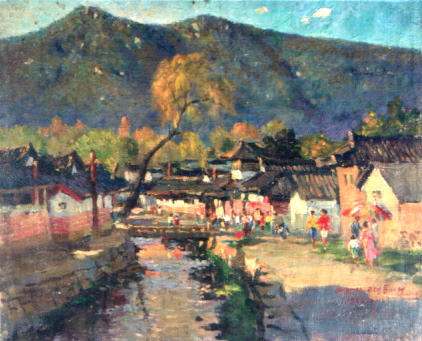
"Koryŏ-dong in Kaesŏng City", 28.1 x 34.2 cm, oil on canvas, 1956
| Im Kun-hong (1912-1979) |
|

"Koryŏ-dong in Kaesŏng City", 28.1 x 34.2 cm, oil on canvas, 1956
| Im
Kun-hong (1912-1979) After graduating from middle school in Seoul in 1927, Im worked in a dentist's office while taking painting classes at the Kyŏngsŏng Western-Style Painting Institute. Still a teenager, he succeeded in placing several oil paintings in the national exhibition (Sŏnjŏn), while also participating in the rival annual exhibitions of the Association of Calligraphy and Painting, a non-governmental organization. He held his first solo exhibit in 1938, and from 1939 to 1946, settled in Manchuria as the director of a graphic design company, traveled throughout China and Manchuria, and held a number of one-man shows. Most of Im's pre-Liberation works are in Impressionist and Post-Impressionist modes of style, but he also experimented with Fauvism. Im and Kim Kwan-ho are the only North Korean artists whose early works were not banned and/or ignored in the South before 1987. While none of Kim's works seem to exist in the South, Im Kun-hong's pre-Korean War work has been preserved by some collectors and his family in Seoul. Im's family claims that he was taken to the North by force right after the outbreak of the war, but this claim seems tenuous as his closest painter friend, Ŏm To-man, with whom he had spent time in China, also chose to join the Communist forces (see his article in the inaugural issue of Chosŏn misul). However, in 1984, Im was honored by a retrospective show in the Lotte Art Gallery in Seoul. Most of the works that have been preserved in the South are from his days in China. After working for several years as a painter in P'yŏngyang, Im moved to Kaesŏng in the late 1950s and in 1961 became the head of the Kaesŏng section of the Korean Artists Union. Two years later, however, he moved to North Hamgyŏng Province where he supervised the production of military propaganda art, an assignment that may indicate a decline in status. Most of Im's known works in the North are in coloring and style very similar to the style he adopted during his time in China. |
_______
|next ->|